 At the moment I’m trying to sift through Winchester’s ashes to find anything still standing after the Remington versus Winchester short and long magnum shootout. Remington won the firearm war, but Winchester gutted the popularity of most of Remington’s Ultra Mag and Short Action Ultra Mag product lines. Remington will go on producing rifles chambered for both Remington and WSM cartridges, Olin Corporation will produce ammo for WSM and WSSM cartridges and Winchester U.S. Repeating Arms will….evaporate someplace in Belgium.
At the moment I’m trying to sift through Winchester’s ashes to find anything still standing after the Remington versus Winchester short and long magnum shootout. Remington won the firearm war, but Winchester gutted the popularity of most of Remington’s Ultra Mag and Short Action Ultra Mag product lines. Remington will go on producing rifles chambered for both Remington and WSM cartridges, Olin Corporation will produce ammo for WSM and WSSM cartridges and Winchester U.S. Repeating Arms will….evaporate someplace in Belgium.
I have never been much of a WSM proponent. At .308 caliber and above, I don’t believe there is enough capacity to create much hustle with heavier bullets, or long bullets, and the guns are typically too limited in action length to provide latitude for increasing COL and net case capacity. At the other end of the caliber spectrum, just where WSM case capacity would begin to work in .243 and .257 calibers, case capacity was unfortunately reduced to the stubby WSSM series. In the mid size caliber group, I found the 270 WSM to have excellent potential and extracting its performance to be relatively straight forward. The only WSM left in my “undecided” theoretical column was the 7mm WSM.
I like .284″ magnums. The sectional density is very good, bullet weight is substantial and the guns I’ve shot in this caliber have been very accurate. I suppose this type of cartridge might fail the “big bear” test, but I’m not sure I would concede even that possibility. I certainly can’t think of any other North American game that would tax this type of cartridge. Playing around with possible loads for the 7mm WSM in simulation, I was surprised by some of the numbers that seemed within reach. So I set out to put together a reasonably priced package of firearm, optics and handloads to see if I could duplicate the simulations that showed the WSM with the potential of staying with the 7mm Weatherby Magnum. While reviewing prospects for the rifle selection, the old adage came to mind, “If it walks like a duck, quacks like a duck, it probably is a duck.” or at least a guy I knew in the Air Force.
The Howa M1500
Brace yourself, there may not be an AT&T or GE factory busily manufacturing telephones. Standing in the aisle at Circuit City, these names clearly screen printed on their respective products, you’d find they look suspiciously similar to phones being sold under a variety of different names. In reality, manufacturing is an expensive proposition, representing heavy investments in capital equipment, large scale facilities and highly skilled labor. Consequently, companies often purchase their products from a central supplier that has already made that heavy investment, while using their own financial resources for other purposes…like a marketing department that can come up with spiffy product names. Sometimes companies buy product of the manufacturing company’s design with minor variation. In ancient days they called this arrangement private labeling. Sometimes a company is asked to manufacturer a customer’s proprietary design, which is typically referred to as contract manufacturing. To offer an example, Weatherby does both. Actions for the Mark V line are produced by an independent company in the United States exclusively for Weatherby and true to Weatherby’s design. Their Vanguard Models are based on Tokyo’s Howa Machinery Limited’s Model 1500 barreled action and purchased from that company. The same basic Howa 1500 mechanical assembly has been sold under the Smith & Wesson and Mossberg brand names, as well as under the Howa brand name. The product sold under Howa’s brand name is imported into the United States by Legend Sports International.
Of course, common manufacture and design sometimes begs the question, “Why not just buy the least expensive brand/model offered since they are actually all the same gun? Well, because the are really not exactly the same, and there is more to a product than tangible goods. The Weatherby has some physical differences, like the fluted bolt sleeve, knurled bolt knob and that spiffy Weatherby stock. Plus, the Weatherby product is offered in Weatherby chambers and it is serviced under Weatherby’s warranty, through the Weatherby service network. If these elements are of consequence to you, then the Weatherby Vanguard is the version of the Howa 1500 you probably want. If you’re planning on shooting a more generic 7mm WSM, then the brand selection may not be so significant and other Model 1500 variation may be more appropriate.
The Howa/Hogue – Say that 10 times fast
Howa Machine makes a number of versions of the M1500 as stainless or blued barreled actions and walnut or synthetic stocked finished rifles. Legacy Arms, the company that imports Howa products into the US, additionally offers specialized models of the M1500. One model has a carbon fiber wrapped barrel from Christensen Arms, another combines the Howa 1500 series barreled action with a Hogue OverMolded stock. In a stoke of creative marketing genius, Legacy labeled the latter the Howa/Hogue. Nice to see a name that’s descriptive of a product. In fact, we were so impressed, we bought one as the basis for this project.

The Hogue stock is made by high temperature bonding an elastomer, let’s call that synthetic rubber, over a very rigid fiberglass frame. The result is a stable structure that is soft to the touch and impervious to oils and solvents. Stippling replaces checkering with a cobblestone pattern, the grip is wide with a palm swell, the barrel floats and the forearm has a wide profile not unlike a comfortable varmint rifle. The stock is pillar bed through aluminum inserts, so floor plate and trigger guard hardware can be properly torqued into place and secure. Personally, I wish Legacy has picked the Hogue stock with the aluminum frame, rather than fiberglass, but I am sure that would have run the cost up considerably. Functionally, the Hogue stock is an excellent assembly and accounts for only 2 lbs 3 oz with a Hogue energy absorbing recoil pad attached. It may not be as pretty as I’d like, especially the termination of the forearm, which look as though an angry Samurai did the final trimming, but it is a comfortable shooting design.
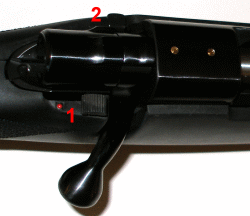
If the stock isn’t exciting, the hardware is better. Parts are nicely finished, even if a bit hefty; with the light stock the gun still weighs 7 1/2 lbs without scope. There is a recently upgraded safety that is three position (1) and a traditional bolt release (2). The top of the receiver shares a profile with the Weatherby Vanguard and Remington Model 700, which means there is a huge variety of scope mounting hardware and systems readily available. The 24″ hammer forged barrel has a #2 contour, a 9.5″ twist and .620″ crowned muzzle; very appropriate for the 7mm WSM. Its only wart is a very small font warning notice that runs 15″ down the top centerline of the barrel, in brief reading “Read the manual”. Overall, the Howa is a very clean and solid assembly.
 The bolt is a 2 lug design with typical 90° bolt rotation; cartridges are push fed. There are three gas ports to allow high pressure bleed off in the event of a case failure. Bolt rotation, open and close and lock up are smooth and positive, much more so than the average Mauser type action. The bolt face is recessed and the overall bolt/action assembly is described as surrounding the cartridge case head in three rings of steel; bolt recess, barrel and the receiver. I noted in earlier text the Model 1500 has a 3 position safety. In the context of the bolt’s operation, the safety lever pushed fully forward removes the safety, one click back puts the gun on safe, but permits opening and closing the bolt, pulled all the way back the safety is on and the bolt is locked.
The bolt is a 2 lug design with typical 90° bolt rotation; cartridges are push fed. There are three gas ports to allow high pressure bleed off in the event of a case failure. Bolt rotation, open and close and lock up are smooth and positive, much more so than the average Mauser type action. The bolt face is recessed and the overall bolt/action assembly is described as surrounding the cartridge case head in three rings of steel; bolt recess, barrel and the receiver. I noted in earlier text the Model 1500 has a 3 position safety. In the context of the bolt’s operation, the safety lever pushed fully forward removes the safety, one click back puts the gun on safe, but permits opening and closing the bolt, pulled all the way back the safety is on and the bolt is locked.
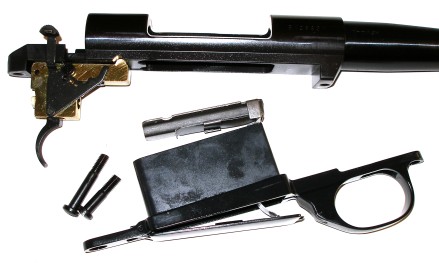
The receiver is flat bottomed and matches up well to the stock’s inletting. Other than factory dabs of locking sealer, the trigger is adjustable. The trigger guard and hinged floor plate are cleanly finished and nicely blued or anodized, the positive yet easy to operate floor plate release is embedded in the front of the trigger guard. There are no plastic parts. Neato.

The action is supported in recoil at three key points: 1. The large recoil lug at the front of the action, 2. the surface if the magazine box, 3. the rear recoil lug – very solid set up.
|
Howa Hogue Summary |
|
| Weight – Empty | 7.5 Lbs |
| Overall Length | 44.25″ |
| Pull | 14.25″ |
| Barrel Length | 24″ |
| Mag Capacity | 3 |
| Trigger Pull | 4 lbs 1 oz |
| Metal Finish | Blued |
| Stock | OverMolded Black |
| MSRP | $529 |
| Real Guns Price | $431 |
Optics that fit the application
The Howa, as noted earlier, is not supplied with metallic sights…or any other sights for that matter. There are lots of ego optics out there, giant objective lenses, 30mm tubes and large ocular lens that are more consistent with a refractor telescope than a rifle scope. There are of course range finding scopes and electronically controlled compensating scopes overpriced American, European and Asian scopes waiting for the those who keep their scopes in their pants or wallet. In keeping with the moderate priced hunting package theme, I selected a Burris Fullfield II and Warne mounts
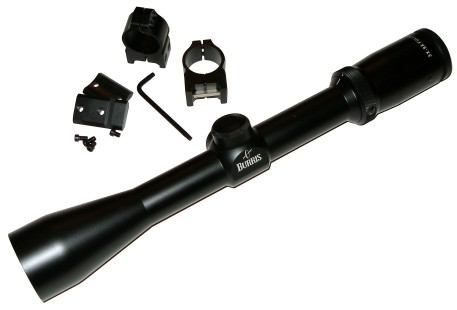 .
.
I think the Burris Fullfield II is a heck of a bargain. Under $200 it is much nicer than any of the lower cost Leupold glass and it has none of the limitations that plaque products from the low end suppliers. Eye relief if good, lens are bright with excellent contrast and focus, the tube is well sealed and the steel on steel adjusters are positive and precise. Eye piece and magnification controls are also positive in adjustment and stay put. The matte black finish is of good quality and Burris has enough respect for the people who purchase their products to include good lens caps and a storage bag for when times the scope is removed from a firearm.
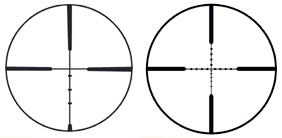 The Burris scope is a 3x-9x-40mm Ballistic Plex in matte black with low profile Hunter’s knobs, Fullfield Tac scopes have tall TAC 2 knobs. The Ballistic Plex reticle, far left, is a bit different than the Ballistic Mil-Dot, near left. The horizontal hold over tics on the lower cross hair are scaled only in the context of a specific cartridge. As an example, for the 7mm WSM with a 200 yard zero set at the intersection of the crosshairs, the selection of a lower horizontal tic would be based on the distance to the target. Starting with the intersecting crosshairs, then counting down the ticks; 200 yards, 300 yards, 400 yards, 500 yards, and 600 yards at the peak of the lower post. I say this is relative because a standard cartridge load like a 140 grain 7mm-08 Remington would play out as 100 yards, 200 yards, 300 yards, 400 yards, and 500 yards. Burris has a chart for virtually any cartridge or load but it is easy to establish the ranges on your own with a little range time or ballistic calculator.
The Burris scope is a 3x-9x-40mm Ballistic Plex in matte black with low profile Hunter’s knobs, Fullfield Tac scopes have tall TAC 2 knobs. The Ballistic Plex reticle, far left, is a bit different than the Ballistic Mil-Dot, near left. The horizontal hold over tics on the lower cross hair are scaled only in the context of a specific cartridge. As an example, for the 7mm WSM with a 200 yard zero set at the intersection of the crosshairs, the selection of a lower horizontal tic would be based on the distance to the target. Starting with the intersecting crosshairs, then counting down the ticks; 200 yards, 300 yards, 400 yards, 500 yards, and 600 yards at the peak of the lower post. I say this is relative because a standard cartridge load like a 140 grain 7mm-08 Remington would play out as 100 yards, 200 yards, 300 yards, 400 yards, and 500 yards. Burris has a chart for virtually any cartridge or load but it is easy to establish the ranges on your own with a little range time or ballistic calculator.
The Ballistic Mil-Dot offers the same capabilities as the Ballistic Plex and ads the further dimension of range finding. The distance from the cross hair intersection to the center of a round mil-dot is equal to 3.6″ at 100 yards. Theoretically, if you know the approximate size of the game you have set your sights on, you can crank up the power, read an indexed sleeve and estimate distance and use the lower reticle ticks for hold over. Or, you can do what I did; fall asleep and hit your nose on your computer’s keyboard halfway through volume three of “How to use a Ballistic Mil-Dot reticle” and select a Ballistic Plex and buy a separate laser range finder like the rest of us common folks who can’t judge distances.
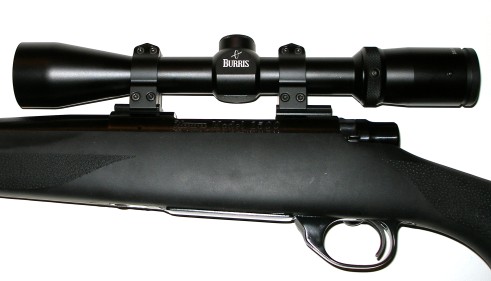
Warnes bases and rings have become a standard for me. They mount low on a receiver, the ring cross keys lock into the bases so the rings can’t move fore and aft and the steel rings hold onto the scope tube like a vise. If you want to remove them, you can in a minute or two, and they do seem to go right back to zero when reinstalled. Medium height rings are more than enough with this 40mm objective lens scope and there is plenty of bolt arm clearance. The set up is also perfect height, at least for me, to put my eyeball in center line with the eye piece without having to crane or bend my neck. The rings are .350″ from base to saddle, adding in the height of bases, the scope tube saddle is .650″ above the barrel.
Where I left off….
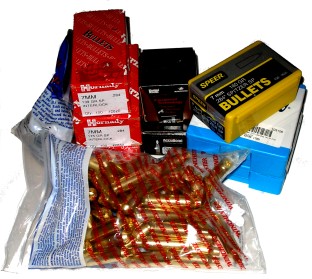 Of course in the middle of a pile of bullets; those that have worked well in 30-06 length 7mm magnums as well as though I thought might work well with the WSM. I also had to tailor powder selection as this is somewhat of a tightrope to walk between too fast and too slow.
Of course in the middle of a pile of bullets; those that have worked well in 30-06 length 7mm magnums as well as though I thought might work well with the WSM. I also had to tailor powder selection as this is somewhat of a tightrope to walk between too fast and too slow.
Working this project while in California, with the shop and everything else sitting in Maine, I also had to put together a more or less portable reloading set up that would not take much room. This was actually fun and will be covered with range results within the next couple of weeks. In the mean time I’m having a lot of fun with the combination, the 7mm WSM may make a an excellent companion round to the 270 WSM.
Thanks
Joe
Howa ’bout a 7mm WSM? Part I
Howa ’bout a 7mm WSM? Part II
7mm WSM Handload Data
The Howa 7mm WSM and other fine firearms can now be purchased at the Real Guns Gunstore.

Email Notification